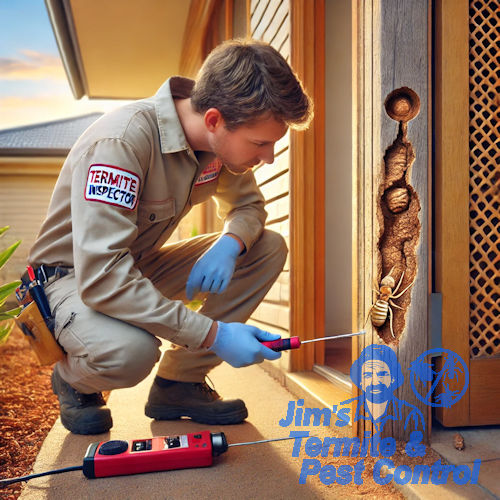Termites are difficult to detect because they hide inside walls, floors, and wooden structures. However, there are warning signs of termites that indicate a possible infestation. Homeowners who notice these signs should schedule a termite inspection immediately to prevent further damage.
This article outlines the most common signs of termite activity and explains why an inspection is necessary if these indicators are present.
For professional and licenced termite inspection and treatment services in South Australia, in particular Adelaide and suburbs, contact Jim’s on 131 546, or complete our free pest inspection quote form.
Common Signs of Termites & An Infestation
1. Hollow-Sounding Wood
When termites feed on wood, they consume it from the inside out, leaving only a thin outer shell. If you tap on wooden surfaces, such as walls, floors, or furniture, and they sound hollow, this may indicate termite damage.
 2. Mud Tubes
2. Mud Tubes
Mud tubes are small tunnels made of dirt and termite saliva. They are usually found along foundations, walls, or other wooden structures. These tubes protect termites from predators and keep them from drying out. The presence of mud tubes is a strong sign of an active infestation.
3. Discarded Wings
Termites swarm when they establish new colonies. After finding a suitable nesting area, they shed their wings. Piles of discarded wings near windows, doors, or entry points can indicate a recent termite invasion.
4. Buckling or Warped Wood
Wood that appears warped, swollen, or buckling may have been damaged by termites. As termites eat away at wooden structures, the wood loses its strength and may begin to bend, sag, or crumble.
5. Unexplained Cracks in Walls or Ceilings
While cracks in walls can be caused by foundation settling, termites can also weaken drywall and wooden beams. If cracks appear suddenly and do not seem related to normal house settling, termites could be the cause.
When to Call for a Termite Inspector
If any of these signs are present, a professional termite inspection is recommended. Even if you are unsure, it is better to be safe than sorry. Early detection can prevent severe structural damage and reduce the cost of repairs.
Conclusion
Recognizing the warning signs of termites can save homeowners thousands of dollars in repairs. If you notice hollow wood, mud tubes, discarded wings, or damaged wood, schedule a termite inspection immediately.
Act Now!
For professional and licenced termite inspection and treatment services in South Australia, in particular Adelaide and suburbs, contact Jim’s on 131 546, or complete our free pest inspection quote form.
FAQs
What are common signs of termite infestation? Termites usually remain hidden inside walls and wooden structures. However, homeowners may notice hollow-sounding wood, mud tubes along walls, discarded wings near entry points, buckled wood and sudden wall cracks. These signs indicate termite activity. Early detection is vital to prevent serious damage. How can I detect hollow-sounding wood? When you tap on wooden surfaces, the wood may sound hollow if termites have eaten from within. This happens because only a thin outer layer remains intact. Consequently, the wood loses its strength. It is important to check all wooden structures and furniture. A professional inspection should follow if you suspect termite damage. What are mud tubes and why do they matter? Mud tubes are small tunnels made of dirt and termite saliva. They usually appear along foundations or walls. Moreover, these tubes protect termites from predators and help retain moisture. Their presence signals active termite colonies. Therefore, it is essential to inspect areas where mud tubes are found. Why do termites discard their wings? Termites swarm when they find a suitable nesting area. After the swarm, they shed their wings. Discarded wings near windows and doors suggest recent termite activity. Thus, seeing piles of wings should prompt further investigation by a pest control professional. What does buckled or warped wood indicate? Wood that buckles, warps, or swells often loses its strength. Termite activity may cause such damage. As termites eat the wood from within, the structure can begin to bend or crumble. Homeowners should remain alert to these changes and consider an inspection when they occur. How do unexplained wall cracks signal termites? Cracks in walls may have several causes. However, sudden cracks or those unrelated to normal settling could be due to termite damage. Termites weaken both wood and drywall. Therefore, if you notice unusual cracking, it is wise to consult a termite inspector promptly. When should I call a termite inspector? Call a termite inspector if you observe any of these signs. Early detection helps prevent severe structural damage. Additionally, professional inspections can save you from high repair costs later. It is always better to be safe than sorry.
